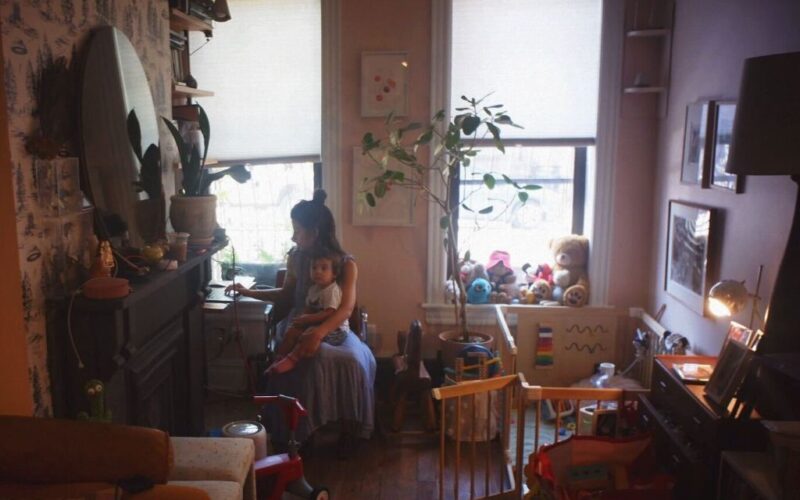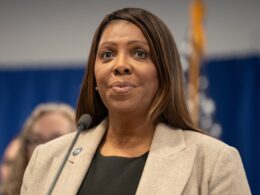Nakeeta Wills pieces together what she can to afford staying in New York City.
A health insurance advisor, Wills relies on a local garden and food pantries to help pay for groceries. Grandparents and “loving aunties” help pay for her 10-year-old son playing violin. Wills took out student loans for a master’s program in business and owes at least $100,000.
Her rent is somewhat reasonable — by New York standards. She pays $1,300 per month for an apartment in Central Harlem, but her son is getting older and bigger. She thinks she’ll need more amenities as she ages too, like a doorman or perhaps an elevator.
Wills checks the city’s affordable housing portal every day, but she doesn’t qualify for many of the units on the site — even though the high cost of living in Manhattan feels out of reach, and her income barely lets her scrape by. She’s even considered leaving the city — for upstate, Maryland or the South — but always decides to stay.
“There’s no real middle ground for somebody who makes the $50K in New York,” Wills said. “There’s just like, nothing here. Can’t do nothing. I can’t apply for no program.”
“I should be able to live comfortably here, and any candidate that supports [that] would definitely get my vote. I’m not here looking for a handout. I am no stranger to hard work,” she added, saying people shouldn’t need to “have nothing in order to get some type of support.”
The challenge Wills and other New Yorkers face has propelled the issue of affordability into the forefront of this year’s mayoral election. If crime and post-Covid recovery were top of mind for voters four years ago, the 2025 election has become a referendum on a more fundamental question:

Can New York can work for anyone but the super wealthy?
With early voting starting this weekend and candidates making their final pitches to voters, many New Yorkers are preparing to cast their ballots based in part on who they think would do the best job of tackling an unprecedented affordability crisis — in which rent has reached record highs, and the annual cost of child care is over $20,000.
Zohran Mamdani, the Democratic frontrunner, has positioned himself as the affordability candidate, running on a platform that includes rent freezes and free daycare. His focus on pocketbook issues was widely credited for his upset victory over Andrew Cuomo, the former governor, in the primary, and has shaped the contours of the race as it nears its conclusion.
Cuomo and GOP candidate Curtis Sliwa have taken note, with each pushing affordability platforms of their own, particularly on housing.
More than 21% of the city’s likely voters said last month affordability was the most important issue that will affect their vote, followed by crime and the economy or jobs, according to a poll from Suffolk University CityView.
Child care, rent emerge as key issues
Skye Momson, 40, is among those voters. A floral designer at an event design and production company, she lives with her fiancé, a musician and small business owner, and their toddler in a 1-bedroom apartment in Red Hook. They all share a Queen-size bed, as the cost of living continues to rise.
“It just seems to be going up and up and up,” Momson said.
The couple pays $2,850 per month for rent, which is about the same as when they moved in a few years ago. But utilities have skyrocketed, with their monthly bill now easily surpassing $300 per month. For child care, they drop-off their 18-month-old son at his daycare the least number of days each week they can balance with their careers — often twice — at a cost of $120 per day. They pay in two installments each month.
“I can’t afford to pay it all at the beginning of the month. It would deplete my paycheck entirely, because that’s when we’re paying our rent as well,” said Momson, who advocates for free child care for all with a coalition of parents called New Yorkers United for Child Care.

“It’s this constant calculus of how much can we really juggle? How many days can we afford this month? It’s really stressful.”
Mamdani has assembled a new coalition of young professional and working class voters by promising non-means-tested free child care, starting at six weeks old, as well as rent freezes for stabilized units.
Cuomo, now running as an independent, is looking to shore up the city’s free preschool program for 3-year-olds, while expanding subsidies for families in poverty. The former governor has also campaigned on increasing affordable housing supply, which Mamdani says is a priority too. Sliwa, the GOP nominee, wants to focus his political capital on bringing vacant rent-stabilized units back online.
Anne Perryman, a Mamdani supporter, isn’t worried about herself as much as she is about the generations that will follow.
When the 84-year-old moved to the Upper West Side’s Lincoln Towers in 1976, she paid $475 a month in rent. Nearly half a century later, she pays $2,200 for the same two-bedroom, rent-stabilized apartment. If Perryman left, she estimated the rent would shoot up to at least $6,000 — the market rate.
“Who can afford that?” asked Perryman. “New York used to be a place where people could come and start careers, and young people could come and live here, and I had that experience.”
Perryman has worn many hats over the years as a mother, journalist, activist and CUNY staffer and serving as the president of the Lincoln Towers Tenant Association. Most recently, the retiree was photographed for a Mamdani mailer earlier this year.
“The rent freeze that he is promising, that is one thing that he can actually do,” she said, compared to some of the Democratic nominee’s other plans that would require buy-in from the governor or the City Council.
Mamdani’s promise to freeze the rent, though, has come under for for being unworkable, with his opponents and skeptics of the concept noting that costs for landlords will continue to climb while their income would be frozen. Pressed on that question during Wednesday’s debate, Mamdani said the city could help them, though he offered no specifics.
Stay or go?
Though affordability became a buzzword during the mayor’s race, the underlying issue has been simmering for years. Esteban Girón of the Crown Heights Tenant Union says it’s the politicians who are finally catching up.
“It’s top of mind for a majority of New Yorkers, which is why something like the Zohran campaign has taken off the way that it has,” Girón said.

“Nobody in the political world expected it, but anybody who’s paying attention in New York, just in general, understands that everybody’s thinking about this issue. They’re thinking about affordability of housing, they’re thinking about their jobs and just not being able to afford to live in the city.”
Stephanie Thompson, 34, is a mom, community college student and nonprofit employee. Not only has she considered leaving New York — she briefly moved out of state, until she got called for her first NYCHA apartment in Alphabet City and returned.
But in the years since, Thompson, who moved to East Harlem’s Taft Houses, said New York has increasingly felt like a city only for the super-wealthy.
Both of her children, 16 and 8 years old, are dyslexic, and she’s paying out-of-pocket for one of them to receive tutoring services. She said movie theater ticket prices have become unattainable, and so has the food at the Shake Shack next to the park where her younger child wants to go on playdates.
Many of her neighbors have jobs in the city’s public schools, construction and the MTA, but they still can’t afford to move out of public housing.
“You either rich and you got it, or you poor and you don’t. There’s no in between anymore. You’re either poor or you’re rich — that’s it. And I think at this point, I don’t think middle class is anymore. I think it’s done… All of my neighbors are city workers.”
“COVID was when it kind of punched me in the face, and I realized, like, I’m literally scraping pennies together to make things work,” Thompson said. “Hygiene products, cleaning supplies, hair products — I don’t shop in my neighborhood anymore. I am beholden to Amazon. I can’t afford the groceries in my neighborhood.”
“It’s not what it used to be. You can’t own — everybody is renting. And most of the people I encounter, they live in public housing. I work with people who live in public housing. We’re all here. We’re stuck.”








